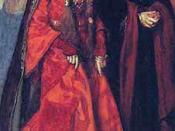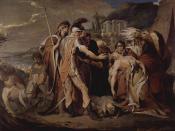An examination of the nature of evil
Defining the term "evil" is a difficult task. Searching for its meaning in the dictionary led me to countless other words such as 'wicked', 'harmful', 'heinous', 'black', and 'villainous'. Needless to say, I didn't find the simplistic explaination that I had hoped for. This in itself proves that the nature of evil is opened to intepretation and debate.
Labelling an individual as 'evil' isn't easy, especially when it's hard to even clearly define the word. King Lear is a tragedy, and, because there is so much violence and murder, it needs to dramatise evil well.
For the most part, in 'King Lear', Shakespeare seems to simplify the concept. Cordelia is wholly good, with no evident faults, and Edmund is entirely evil. The audience is immediately aware of their nature.
Evil is detectable throughout the play but appears to be particularly prominent in certain scenes and particular characters.
I will focus on three of the evil characters, Edmund, Goneril, and Regan and make a comparison with the good character of Cordelia.
Through the use of dramatic irony, Shakespeare displays evil from the very start, In Act I Scene 1. Goneril and Regan are already beginning to direct hostility towards their father. It is suggested by them that it is almost a disease to be old and that he may have to be dealt with like a disease.
In contrast to this is in Act II Scene 7. In this scene, evil is portrayed in alot more of an up-front style. The servants have been sent to retrieve Gloucester and the sisters. Goneril and Regan, begin to discuss Gloucester's fate "Regan: Hang him instantly Goneril: Pluck out his eyes" Regan and Goneril are almost arguing in this scene, seeing who can come up with...


